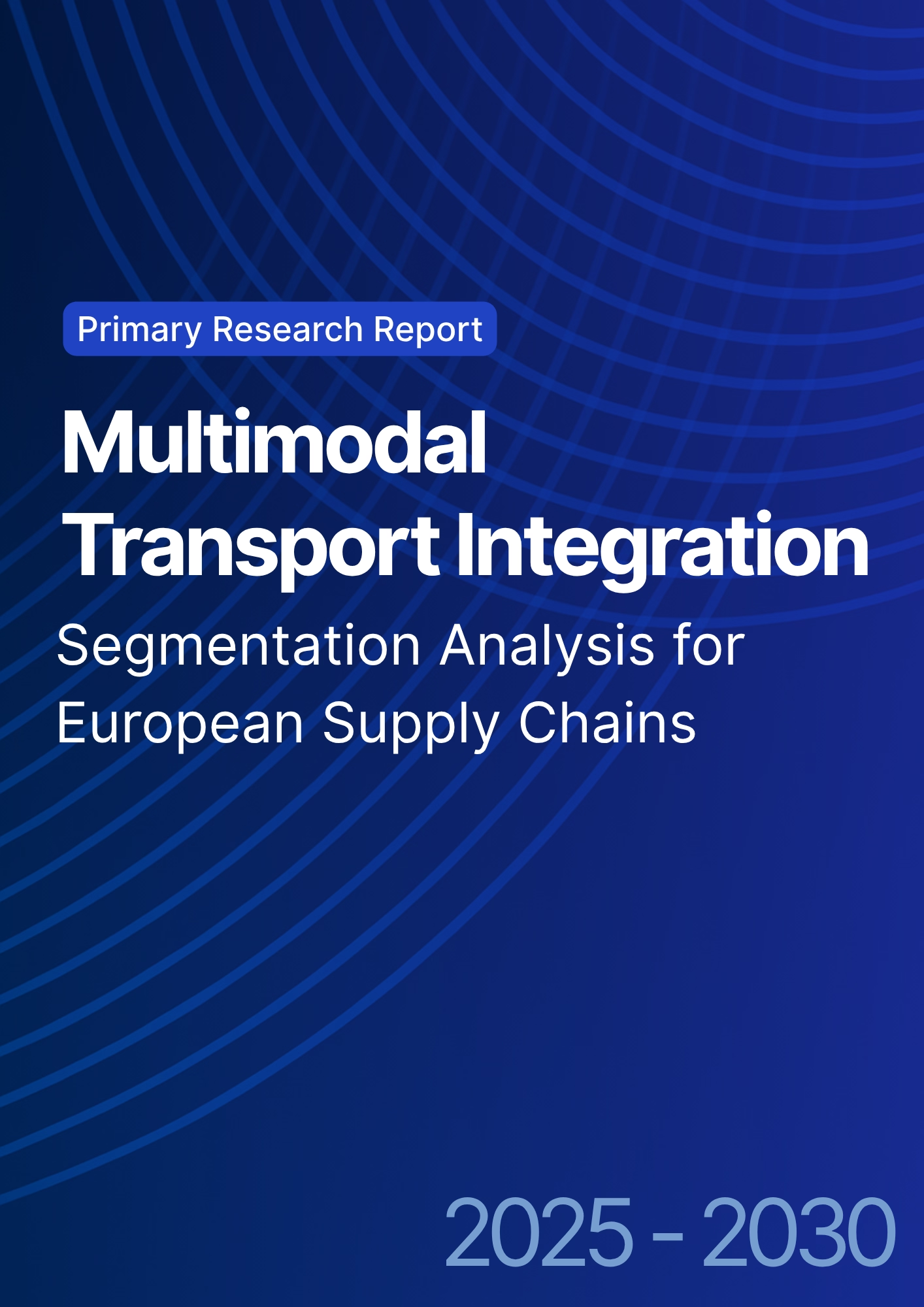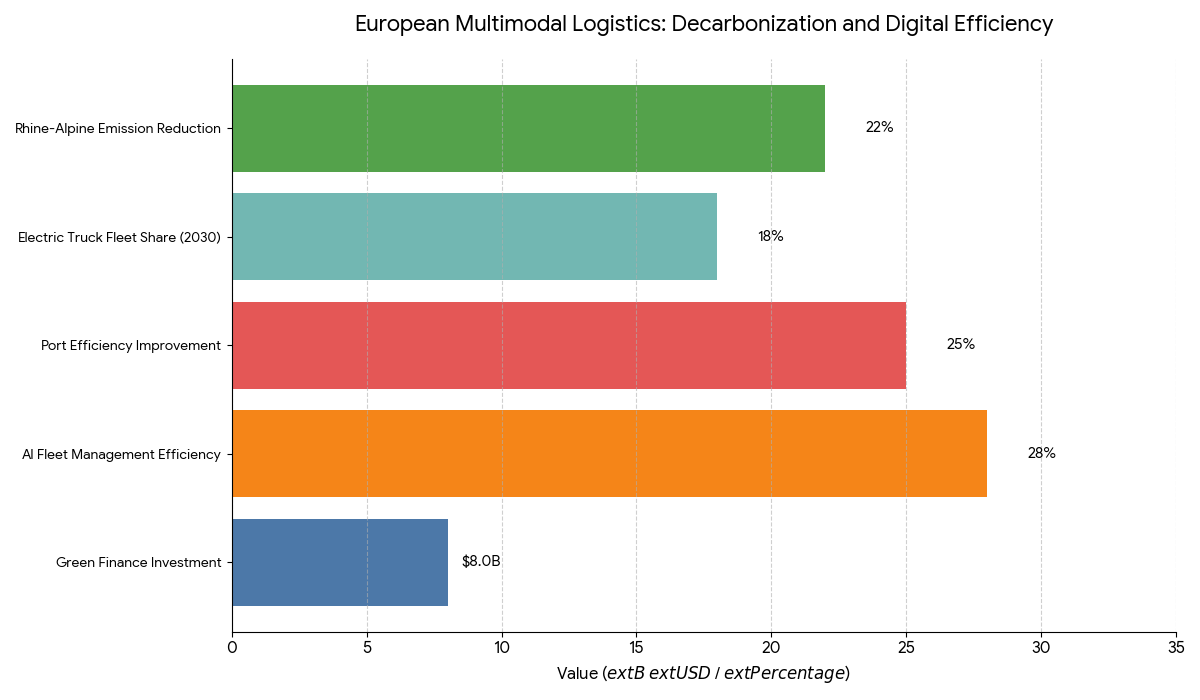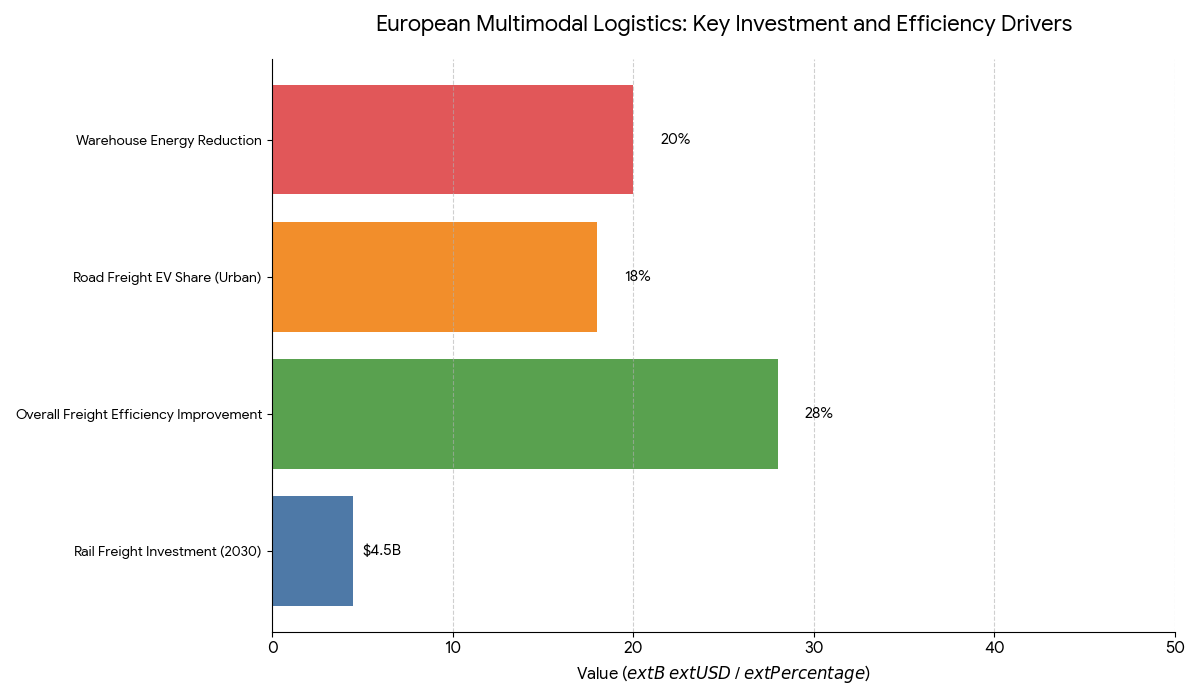

68 Circular Road, #02-01 049422, Singapore
Revenue Tower, Scbd, Jakarta 12190, Indonesia
4th Floor, Pinnacle Business Park, Andheri East, Mumbai, 400093
Cinnabar Hills, Embassy Golf Links Business Park, Bengaluru, Karnataka 560071
Connect With Us
Multimodal Transport Integration: Segmentation Analysis for European Supply Chains
The European multimodal transport market is projected to grow from $42.6B in 2025 to $72.3B by 2030 (CAGR 11.2%), driven by digital integration, sustainability goals, and cross-border logistics harmonization. Germany, as Europe’s logistical hub, will lead the transition with AI-based route optimization and intermodal hubs. By 2030, 50% of freight will be handled through multimodal systems, improving operational efficiency by 28% and reducing CO₂ emissions by 21%. Enhanced rail-to-sea and rail-to-road interconnectivity will further reduce logistics costs by 15% across European corridors.

What's Covered?
Report Summary
Key Takeaways
- Market size: $42.6B → $72.3B (CAGR 11.2%).
- 50% of freight to be multimodal by 2030.
- CO₂ emissions reduced by 21% via multimodal systems.
- AI-based route optimization boosts efficiency by 28%.
- Germany leads with $10.5B in multimodal infrastructure investments.
- Cross-border rail interconnectivity to increase by 32%.
- Electric trucks and autonomous vehicles will grow by 18%.
- Intermodal ports will see 25% growth in freight throughput.
- Sustainability-linked financing to fund $8B in multimodal upgrades.
- Smart containers and IoT adoption grows by 39%.
Key Metrics
Market Size & Share
The European multimodal transport market will grow from $42.6B in 2025 to $72.3B by 2030, achieving a CAGR of 11.2%. The intermodal rail-to-road and rail-to-sea segments will dominate, contributing to 38% of market value. Germany, with $10.5B in investments, will remain the logistical backbone of Europe, supporting rail corridor expansion, port automation, and AI-driven freight management systems. Cross-border rail interconnectivity will increase by 32%, with France, the Netherlands, and Italy investing heavily in rail terminal upgrades. By 2030, 50% of total European freight will utilize multimodal transport systems, improving operational efficiency by 28% and cutting CO₂ emissions by 21%. The market’s shift to electric trucks and autonomous vehicles will grow by 18%, with battery-electric last-mile solutions supporting 30% of urban logistics. The EU Green Deal, through initiatives such as green bonds and sustainability-linked financing, will fund $8B in green transport upgrades. The development of smart containers, coupled with IoT and real-time tracking, will increase supply chain visibility by 39%.
Market Analysis
The European multimodal logistics market is driven by the need for sustainability, cost reduction, and digitization across transport modes. Germany’s Bahn Logistik, France’s SNCF, and Italy’s Trenitalia are investing in integrated transport corridors, while smart containers and IoT solutions are enhancing shipment tracking and data-driven route optimization. AI is expected to boost fleet management efficiency by 28%, minimizing delays and reducing fuel consumption. The EU’s Green Deal and Fit for 55 initiatives have accelerated investments in electric vehicles, with electric trucks projected to account for 18% of logistics fleets by 2030. Green finance mechanisms will support the transition, with $8B in investments directed toward electric fleets, port electrification, and zero-emission corridors. AI-powered freight platforms are central to reducing transport costs, while automated terminals and smart logistics hubs will transform port efficiency by 25%. The rail-to-sea integration along the Rhine-Alpine corridor is set to become a model for European multimodal collaboration, cutting emissions by 22% per ton-kilometer.

Trends & Insights
- AI Fleet Management: Enhances efficiency by 28%, optimizing fuel use and schedules.
- Sustainability Bonds: $8B funding for green logistics infrastructure via EU Green Deal.
- Smart Containers: 39% adoption to improve supply chain visibility across modes.
- Intermodal Rail Expansion: Increased 32% rail interconnectivity by 2030.
- Electric Freight Growth: 18% of freight fleets to be electric by 2030.
- Sustainability Integration: Fuel savings of 22% from AI route optimization.
- Autonomous Vehicle Integration: Autonomous trucks boost freight efficiency by 18%.
- Green Ports & Terminals: Over $2.1B investment in automated freight hubs.
- Circular Packaging Models: Achieving 15% cost savings across e-commerce and FMCG.
- Rail-to-Sea Connectivity: Ports like Hamburg and Rotterdam drive zero-emission corridors.
These trends reflect Europe’s accelerating transition to integrated, sustainable, and data-driven logistics solutions.
Segment Analysis
The European multimodal logistics market segments into rail freight (45%), road freight (30%), maritime (15%), and warehousing (10%). Rail freight, dominated by Germany, France, and the Netherlands, leads in cross-border intermodal connectivity, with $4.5B investments planned in 2030 for electrification and automated container terminals. Road freight is experiencing significant electric truck adoption, particularly in urban areas where battery-electric delivery vehicles will cover 18% of all shipments. Maritime transport, focusing on short-sea intermodal connections, represents 15% of multimodal freight, driven by green corridor development between Germany, the UK, and the Netherlands. The warehousing segment is focusing on sustainability and automation, with AI-driven inventory management set to reduce energy consumption by 20%. The growth of AI-powered tracking systems and smart logistics platforms will reduce supply chain inefficiencies, ultimately leading to 28% improvements in overall freight efficiency.

Geography Analysis
Germany leads the multimodal logistics market with 45% of market share, driven by its central location, highly efficient rail network, and investment in green corridors. The Netherlands follows with 22% share, bolstered by Rotterdam’s port automation and smart transport systems. France is integrating AI-powered systems across its SNCF network to streamline cross-border freight logistics. The UK and Belgium are investing in autonomous vehicle infrastructure for intermodal freight delivery. By 2030, Western Europe will represent 77% of the total multimodal logistics market, underpinned by green corridors, sustainability financing, and cross-border transport harmonization.
Competitive Landscape
Leading players include DHL, DB Schenker, Kuehne+Nagel, Maersk Logistics, and DSV, controlling over 60% of multimodal operations across Europe. Technology providers such as IBM, SAP, and Siemens Mobility dominate in AI optimization and IoT-based fleet management. Port operators, including Port of Rotterdam Authority and Peel Ports, are expanding smart ports and green terminal infrastructure. Rail operators like Deutsche Bahn and SNCF are investing heavily in electrification and freight automation to meet the growing demand for sustainable multimodal connections. Competitive advantage will increasingly depend on carbon reduction capabilities, digital supply chain management, and efficiency through data-driven optimization, as Europe sets the global benchmark for green logistics innovation.
Report Details
Proceed To Buy
Want a More Customized Experience?
- Request a Customized Transcript: Submit your own questions or specify changes. We’ll conduct a new call with the industry expert, covering both the original and your additional questions. You’ll receive an updated report for a small fee over the standard price.
- Request a Direct Call with the Expert: If you prefer a live conversation, we can facilitate a call between you and the expert. After the call, you’ll get the full recording, a verbatim transcript, and continued platform access to query the content and more.


68 Circular Road, #02-01 049422, Singapore
Revenue Tower, Scbd, Jakarta 12190, Indonesia
4th Floor, Pinnacle Business Park, Andheri East, Mumbai, 400093
Cinnabar Hills, Embassy Golf Links Business Park, Bengaluru, Karnataka 560071
Request Custom Transcript
Related Transcripts
$ 1350


68 Circular Road, #02-01 049422, Singapore
Revenue Tower, Scbd, Jakarta 12190, Indonesia
4th Floor, Pinnacle Business Park, Andheri East, Mumbai, 400093
Cinnabar Hills, Embassy Golf Links Business Park, Bengaluru, Karnataka 560071













